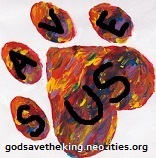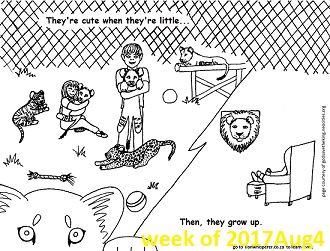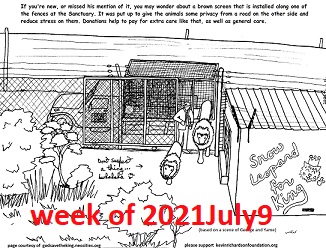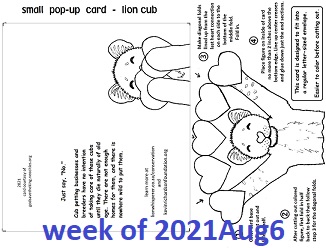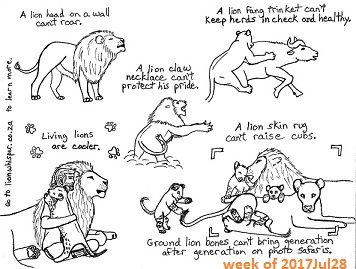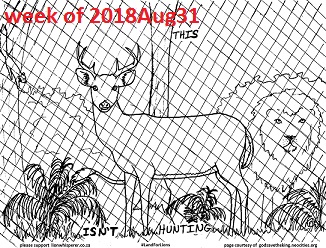Unicorn's Guide to the Galaxy - uh Sanctuary ^,^
~*~ Guide Main Page ~*~
~*~ Is Kevin Richardson a hypocrite? ~*~ Breeding ~*~ Releasing ~*~ Cub Petting ~*~
~ Canned Lion ~ Ask Meg & Amy + misc. ~ Teeth ~ Surgery ~ Hyena ~ Leopards ~ Enrichment ~ Volunteering ~
~ * ~ CUB PETTING and CANNED LION ~ * ~
World Lion Day is August 10.
2021May - finally hope for real change ~ SA to ban lion breeding for cub petting
This page concentrates on the main negatives of captive lion breeding - the cub petting industry and the canned lion industry - but these negatives also apply to any captive predator breeding business. Cubs from tigers, leopards, cheetahs and others are often offered alongside lion cubs for petting - and, later, for killing.
White lions are often strived for at breeding facilities to draw in more unwitting tourists. Some are lighter in color than others, but did you know that white lions are not albino? They're leucistic, which is a partial loss of pigmentation making them lighter than normal. [True albinos have red eyes and all pink skin.] White lions aren't really white, either. ;p They're actually a pretty cream color. ^_~ However, it is carried on recessive genes, and the lions are often in-bred to get the coloring. This causes undesirable traits to emerge as well, often with health issues that can cause them suffering and even shorten their natural lives. ~*~ KR in-depth on leucism
CUB PETTING INDUSTRY
George & Yame were rescued from a cub petting vendor in Spain. They were so malnourished that George suffered permanent damage to his body. Kevin took them in, and with his dedicated loving care, Georgie has managed remarkably well and, though his stamina doesn't match Yame's, is now a feisty adult. ^_~
Their story prominently illustrates some of the ills of the cub petting industry that unwitting tourists don't see, or turn a blind eye to.
Mass breeding of captive lions for thousands of cubs for tourists to pet, their owners have no intention of giving them long enriched lives. Unlike those cubs, Sanctuary lions will never be sold or discarded as they age.
after Georgie's cataract surgery
lol the instant change when he notices the camera ^o^first walkies, Georgie's bad legs
what dedicated loving care can heal
more on their journey, malnutrition used to keep cubs small longer
Georgie now has a spring in his step
a documentary was made about them in 2016
"From Cubs to Kings" - watch a trailer of itIn a mid-2021 video of Kevin with George and Yame, he brings up people asking why shouldn't they be able to do what they want and pet a lion cub?
Unfortunately, I know people exactly like how he describes. "What's the big deal? I want, I want, I want." Even people in my own family would gladly cling to those false promises and gimmicks the cub petting facilities feed tourists, even if I tried to enlighten them.
What's the harm in cub petting? Coloring page 3 (above), from way back at the beginning of this site in 2017, still says it pretty well for me. Cub petting facilities have no intention of taking care of those thousands of cubs until they die naturally of old age. The cubs people pet today are going to become trophies and snakeoil as soon as they're adults. When people pay to pet and handle cubs, they are encouraging and enabling the continuous overbreeding of more and more cubs that have no good future.
They don't stay little for long, so take your hands off your ears, open your eyes, stop singing "lalalalala" and look at the big picture. Like Kevin points out, even just one lioness being bred at each of those facilities produces thousands of cubs. Think about how many cubs thousands of overbred lionesses produce - and then think about their lives.
[This George and Yame scene is from Beat the Clock!.] Fun page, but serious thoughts...
(This pop-up card activity / craft was posted in 2021 as a way for youngsters to learn about and help spread awareness about the ills of the cub petting industry.)
A lot of people don't realize that cubs offered for petting or photos don't live very long lives. People either simply don't think about it, or they may assume the cubs are well cared for until they die naturally of age. Check out KRWS Lion Conservation and KRF Status of Lions to learn what really happens to them. A little thought can go a long way toward change. ^_^
CANNED LION
"Canned lion" and "canned hunting" is how almost all captive-bred lions end up - if they survive to adulthood and aren't put back into the breeding industry. People who like to kill just for the sake of killing will pay around $40-50,000, or more, to kill these lions. Thousands of dollars are paid for their skeletons, too, for the bone trade that caters to mainly Asians that claim animal parts have magical healing powers. - They don't.
In 2019, a movie Kevin helped with was released to highlight the ills of the canned lion industry. It's called Mia and the White Lion, and the cubs used for the movie were taken from that industry and will live out their lives safely at the KRWSanctuary. Here's a few videos featuring them:
Thor's Pride: From Cubs to Adults
Thor's Group 360 degrees ~ Behavioural ChangesCanned lions, point-blank: Captive-bred, hand-raised lions start out as cubs in petting zoos/parks, stripped from their mothers so she will come into heat sooner and quickly produce even more cubs - because they don't stay small for very long and need continually replaced with new ones. The little cuties are subjected to frequent public handling (whether they're in the mood or not) and are often purposely malnourished to keep them smaller longer (some die). Within a few months, they're too big for that and are then subjected to "walks" with groups of strangers with sticks to ward off the rambunctious youths. At two to three years of age, they're uppity teenagers and too dangerous for that. From there, they go back into the breeding industry or are killed for profit.
That involves a bottle-fed, hand-raised and cuddled cub that is now an adult with no fear of humans being put into a different enclosure and someone paying big bucks to go in and shoot at them. (No matter how large the enclosure, the lions can still only go so far and have no chance at all for escape.) From what I've seen, many, if not most, have no actual hunting skills. They just want the status quo of having shot at a lion. (I would rather be known for protecting them, wouldn't you?) These lions may even be coming toward the humans looking for a treat or affection. They are sometimes drugged, or baited, to make them easier targets. ("baiting" is where they put out a carcass to attract the lion to a certain spot and keep him/her distracted)
Surely, we can be better stewards than that.
Trophy killers (it's not "hunting" ;p): If these people were truthfully interested in helping conservation, as they claim they are, they would donate that money with no strings attached. They wouldn't need to kill something for a dust-collecting trophy in return. They could pay that money to assist in protection against poachers, restore and protect wild habitat, or participate in transporting animals to safer places or areas that need the genetic diversity.
They also claim their money goes to the communities local to the facility / business.
The reality, unfortunately, is that very little, if any, of the money paid actually goes to the communities - or even into actual conservation efforts. These lions are bred and killed for the profit of the owner. Period.
If the captive-bred cub petting and trophy industry is so great for "helping" wild lions, WHY are their numbers rapidly declining? You can't keep using the same old excuse when the facts knock it flat.
Like I've said before: Killing things is easy. Keeping them alive and protected takes real men.
If they are real hunters, they need to take their blinders off. And shoot with a camera. ;p
Bone trade: Having driven tigers to less than 4,000 left, they are now using lion parts for exotic tiger products - such as tiger-bone wine. Lion and tiger skeletons are hard to tell apart, so thousands of lion skeletons are exported to Asia and elsewhere to use in place of tiger bones. I've read that even other animal bones have been substituted. What, really, is the dire need for any specific animal when substitution is so readily accepted?
Rhino horn is not even really horn. It's made of keratin, the same as fingernails, hair, animal claws and hooves... So are pangolin scales. That market is driving animals to extinction for everyday things that are nothing special.
It's all just placebos. If consumers of these products truly believed such things actually work, they would be fighting tooth and nail to protect these species, instead of driving them to extinction without a care then merrily switching to another.
Even in this day and age of advancement, things like this are still going on, and we could lose our king of beasts.
The manufacturers surely know the truth, but perhaps some consumers don't realize that the animals used are being wiped out. I didn't know lions were in danger until 2017. Also, many of the effects they're buying these products for can easily, and actually effectively, be achieved with sustainable herbal remedies. Animal parts don't contain anything worth driving them to extinction for. Awareness and education is key.
What is Canned Lion Hunting? ~ * ~ What's a lion worth? 2016 ~ * ~ Foundation in-depth on it 2019
Industry breeders will assure tourists that when the cubs grow up, they'll "go to good homes", or be released into the wild. The reality is: There are no "good homes", and releasing into the wild is not a legitimate option. A lot is covered in this 60 Minutes interview with Kevin and look into the cub petting and canned hunting industry - 15mins.
While fighting to end the industry, we need to be aware of something - which the park owner they talk to even mentions in that video: Other people will be affected when the industry gets banned. For one, people, usually villagers, whose income is breeding stock for the meat that feeds the captive lions on the breeding farms will also need to find a new way of life.
Too, where are all the lions on the farms going to go when their owners suddenly have no more use for them? It's not as simple as just saying, "Let's ban captive-lion breeding farms." There's a lot to take into consideration and address along with it to make it feasible and a change that's fully welcomed by the communities surrounding it.
Kevin on South African government decision in July 2017, lion bone demand and more. A serious topic and 27 minutes long. - I just love his, "In my sanctuary, I have 30 lions. It's very easy, because I can count them.", in response to the government being very vague as to how many captive lions there actually are. 9,9 Seems pretty silly to me, too.
BrightVibes video outlining the issues and mission
Instagram:
'lions are revered around the world, must stop canned hunting'2018Nov - SA gov recognizes captive breeding industry bad for rep
a good start ~*~ and a step back
Keep pushing: They can't ignore us forever.update 2021May -finally hope for real change
SA to ban lion breeding for cub petting~ * ~ back to top ~ * ~
~ * ~ * ~*~ * ~ * ~Be a steward of the Earth.
~ * ~ * ~*~ * ~ * ~
gstk83@catlover.com
[I make the printable images to be around 8x11 inches to fill a sheet of regular letter-size paper when printed. Coloring pages may be printed from here and made copies of for non-profit, free-of-charge use only. Plant seeds! ^_^]
